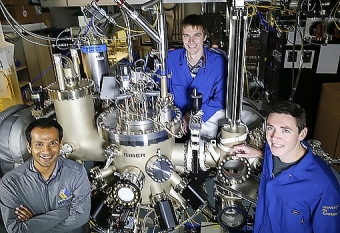
For the past four-plus decades, the vast majority of semiconductors used in LEDs, optical communication, and light detection have been “III-V” materials, so called because they are compounds made by combining elements from groups III and V in the periodic table.
Kunal Mukherjee, an assistant professor in the Materials Department in the UC Santa Barbara College of Engineering, works extensively with III-V materials, but as a materials scientist, he is also interested in exploring new systems and developing new approaches to using familiar systems. He recently received a five-year, approximately $593,000 National Science Foundation CAREER Award to study IV-VI semiconductor materials, which are made of elements from those groups in the periodic table.
“When you make devices to emit and detect at these [infrared] wavelengths, you have to grow them very, very carefully; otherwise, you can have whole rows of atoms that are not in the right place,” Mukherjee says. “A defect of this kind grows over time in the device as you’re running it, causing it to malfunction. We’ve seen how bad defects can be in III-V infrared lasers, so our long-term thinking was, can we find a material that has the intrinsic properties of a III-V material but is not as sensitive to defects?
The team hypothesizes that a unique mixture of metallic, covalent, and ionic bonding of atoms in a IV-VI material is what lends immunity to defects. “To address one part of the proposal, we want to try to verify this. We want to prove scientifically that there is immunity in the IV-VI, and then uncover the mechanism that confers the immunity,” Mukherjee says. read more



